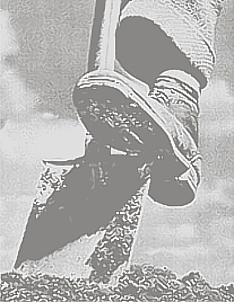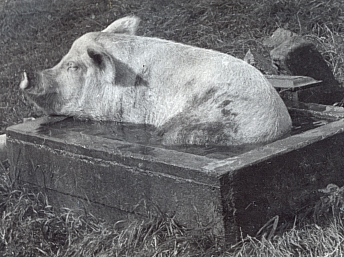Dig for Victory and Self Sufficiency by Roger Ashton (Brock)
| Dig for Victory
My farm certainly gained from WWII’s requirement for extra home grown produce. The workforce was supplemented with extra staff, Land girls! that certainly improved the working day, so I am told! There’s a certain lady in Wem, Ethel, who will remember those days well, not for any hanky panky reasons I hasten to add. The only downside in those war years was the total power of the War Agricultural Committee, a government body that dictated what you could and could not do. The War Agricultural committee controller in our area was a gentleman called Mr Knight, a very forthright Scotsman who started off on his first visit to our farm by giving us an ultimatum about a 50 acre long, rectangular, and flat field. “Plough it all up now or I will bring trenching machines in, it’s a potential enemy landing strip!” So Dig for Victory was not only an essential need at that time it was also a victory for British farming and the tremendous progress it made over the next 50 years with the help of the 1946 Agricultural Act and the financial aid provided by our entry into Europe with the Common Agricultural Policy. This article first appeared in ‘The Wemian’ (Summer 2007). Our thanks to Roger Ashton and 'The Wemian' for allowing us to reproduce it. |
| Self-Sufficiency Farmers, as producers of food have an advantage over the majority of consumers in that certain basic foods can go straight from farmyard or field to farm kitchen. Of course some processing is necessary with some of these products. In this day and age the temptation of the supermarket means the farmer’s wife usually bypasses the inconvenience of home processing and buys her food goods at the retail end.
Bacon sides and hams were placed, after allowing cooling, in two large salting pans 3 foot by 41/2 foot each and 6 inches deep in our cellar where there was a constant low temperature and allowed to cure for several weeks. Incidentally these pans were of wooden construction sitting on two two-foot high brick foundations, and were lead lined! Presumably the salt couldn’t damage lead but I do wonder about the health risk! On removal from the pans bacon sides and hams were hung in muslin bags on large hooks fastened to the beams in our kitchen where the dry curing could be completed. As a youngster I recall that the ham was delicious but the bacon was too fatty for me. Other Wem butchers would provide this service at that time (Ratcliffe’s, Johnson’s, Evan’s, Rutter’s and Richard Hall). Self-sufficiency on dairy farms has continued for decades, milk of course, and the potential to make your own butter and cheeses. Chicken eggs needed only to be collected and potatoes removed from the store to kitchen. A lot of farms had their own bread oven, and farm cottages too; small hand grinders were used to process the wheat into flour for home consumption. I knew a certain person (Edie) who as a young girl would have to go “sticking” after returning home from school to amass starting fuel for the bread oven fire box. In the year 2008 self-sufficiency in organic dairy farming is vital as bought-in concentrate ration has rocketed to £350 per tonne and the challenge is to grow your own quality protein, an essential food ingredient for milking cows. Everyone can become more self-sufficient in homegrown food and do their health a good turn too! Fresh fruit and vegetables can be grown in quality composted soil even if it is only in grow bags, tubs or window boxes; even quick growing cress or beans sprouts can provide us with valuable health giving nutrients. This article first appeared in ‘The Wemian’ (Spring 2008). Our thanks to Roger Ashton and 'The Wemian' for allowing us to reproduce it.
|
 This title brings back memories of World War II when the country suddenly found it required home grown food.
Reliance on imported foods was huge when war started as British agriculture had been run down during the years of the depression – doesn’t that ring a bell with the state
of farming in this country today? – and when German U-Boat attacks began sinking merchant shipping food supplies quickly dwindled. It also placed great relevance on growing
your own food for the family on allotment and home vegetable plots. The positive value of this situation was the wonderful feeling of togetherness that developed when families
and farm workforce rolled their sleeves up and got stuck into some physical work all with the common mindset of beating “Jerry”. There was also the added reward of eating your
own home grown produce. This was very good for one’s health in terms of fresh air, exercise, quality real food and mental satisfaction. It occurs to me that my title
“Dig for Victory” should now be re-introduced as an incentive for people to change their life style from a sedentary existence with its proneness to poor physical health and
unhappy mindset, to a much more active one which would bring greater happiness levels in term of the “feel good factor” i.e. physical and metal wellbeing. A personal victory goal.
This title brings back memories of World War II when the country suddenly found it required home grown food.
Reliance on imported foods was huge when war started as British agriculture had been run down during the years of the depression – doesn’t that ring a bell with the state
of farming in this country today? – and when German U-Boat attacks began sinking merchant shipping food supplies quickly dwindled. It also placed great relevance on growing
your own food for the family on allotment and home vegetable plots. The positive value of this situation was the wonderful feeling of togetherness that developed when families
and farm workforce rolled their sleeves up and got stuck into some physical work all with the common mindset of beating “Jerry”. There was also the added reward of eating your
own home grown produce. This was very good for one’s health in terms of fresh air, exercise, quality real food and mental satisfaction. It occurs to me that my title
“Dig for Victory” should now be re-introduced as an incentive for people to change their life style from a sedentary existence with its proneness to poor physical health and
unhappy mindset, to a much more active one which would bring greater happiness levels in term of the “feel good factor” i.e. physical and metal wellbeing. A personal victory goal. When times were hard during and after the Second World War with shortages and rationing farms did do
some home processing and I remembers that we kept a few pigs to rear to bacon weight (90kg) and employed a local butcher to slaughter and dress them at home. This
particular gentleman will be well known to older Wem residents who have lived in the Wem area for many years. Wilf Smith would arrive at the farm early morning with
all the necessary equipment, which included a very large wooden tub. Wilf was short in stature, unlike his son Peter, and his wit was as sharp as his knives. A clean,
concreted area was required and our lean-to at the back of the house was ideal having shelter and fresh air. Two pigs were brought to the site, stunned, bled and put in
the tub, which contained boiling water and all the hair was quickly scraped off. A block and tackle fastened to the main beam of the lean-to enabled the pigs to be
winched vertically to a position where they could be gutted and cleaned.
When times were hard during and after the Second World War with shortages and rationing farms did do
some home processing and I remembers that we kept a few pigs to rear to bacon weight (90kg) and employed a local butcher to slaughter and dress them at home. This
particular gentleman will be well known to older Wem residents who have lived in the Wem area for many years. Wilf Smith would arrive at the farm early morning with
all the necessary equipment, which included a very large wooden tub. Wilf was short in stature, unlike his son Peter, and his wit was as sharp as his knives. A clean,
concreted area was required and our lean-to at the back of the house was ideal having shelter and fresh air. Two pigs were brought to the site, stunned, bled and put in
the tub, which contained boiling water and all the hair was quickly scraped off. A block and tackle fastened to the main beam of the lean-to enabled the pigs to be
winched vertically to a position where they could be gutted and cleaned.